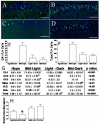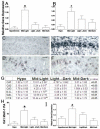Time-of-day determines neuronal damage and mortality after cardiac arrest
- PMID: 19664712
- PMCID: PMC2760634
- DOI: 10.1016/j.nbd.2009.07.032
Time-of-day determines neuronal damage and mortality after cardiac arrest
Abstract
Ischemic events in humans are not evenly distributed across the day. To discriminate between temporal differences in the incidence of ischemia and susceptibility to ischemic events, we examined the outcome of global ischemia in a murine model at three time points during the day. Global cerebral ischemia in mice during the light phase impairs survival and exacerbates outcome compared to ischemia at other times of the day. Specifically, mice that underwent cardiac arrest during the light phase had greater numbers of degenerating neurons, greater microglial activation, and increased proinflammatory cytokine production in the ischemia-vulnerable hippocampus, as well as increased locomotor activity. Time-of-day differences were not altered by the melatonin receptor antagonist luzindole. Our results document that brain tissue displays endogenous fluctuations in susceptibility to ischemic damage and demonstrate that small differences in time of onset can significantly influence ischemic outcomes.
Figures






References
-
- Antolin I, et al. Neurohormone melatonin prevents cell damage: effect on gene expression for antioxidant enzymes. Faseb J. 1996;10:882–90. - PubMed
-
- Bain RJ, et al. Serum cortisol levels predict infarct size and patient mortality. International Journal of Cardiology. 1992;37:145–50. - PubMed
-
- Barlow-Walden LR, et al. Melatonin stimulates brain glutathione peroxidase activity. Neurochemistry International. 1995;26:497–502. - PubMed
-
- Becker LB, et al. Outcome of CPR in a large metropolitan area--where are the survivors? Annals of Emergency Medicine. 1991;20:355–61. - PubMed
Publication types
MeSH terms
Grants and funding
LinkOut - more resources
Full Text Sources
Medical

